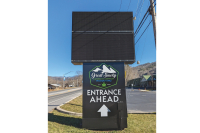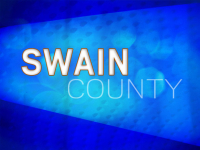Potential free clinic partnership sparks both enthusiasm and concern
 A partnership that could quadruple patient volume and expand medical staffing for the uninsured of Jackson County has been the subject of a flurry of meetings and conversations since The Good Samaritan Clinic of Jackson County announced last week that it’s moving toward a partnership with Hendersonville-based Blue Ridge Health Center.
A partnership that could quadruple patient volume and expand medical staffing for the uninsured of Jackson County has been the subject of a flurry of meetings and conversations since The Good Samaritan Clinic of Jackson County announced last week that it’s moving toward a partnership with Hendersonville-based Blue Ridge Health Center.
Following a meeting Thursday that involved more than 30 people spanning government, health care and nonprofit organizations, enthusiasm was easy to detect.
“I think it’s a positive for the citizens to have Blue Ridge come in and offer services they offer to low-income, noninsured — and folks with insurance can go there, too,” said Jackson County Commissioner Mark Jones, who also sits on the boards for Good Samaritan and the county health department.
“They’re projecting to increase the number of patients being seen in the Jackson County area,” agreed Commission Chairman Brian McMahan. “It’s a fairly significant increase in who’s going to be served, and all that sounds great. I’m very proud and pleased to hear that.”
“I think it’s a good opportunity to really increase access and really help increase quality care to our community, to those folks that don’t have the means or the ability to obtain health care,” said Doug Keskula, dean of the College of Health and Human Sciences at Western Carolina University and a Good Sam board member. “It’s a great vehicle to be able to provide that service.”
Blue Ridge, around since 1963, is a nonprofit community health center that operates on a combination of federal grants, patient revenue and private grants and donations. The partnership would involve Blue Ridge coming into Jackson County, bringing its resources and organizational structure to bear on Good Sam’s mission to offer health care to those who can’t afford it. It’s unclear what, exactly, the partnership would look like — Good Sam is still in the midst of a strategic planning process, and the final fallout will hinge on the outcome of a federal grant application Good Sam and Blue Ridge are putting together.
Related Items
If awarded, the Access Point Grant, given by the U.S. Health Resources and Services Administration, would provide $650,000 per year for two years to the new Sylva Health Center. In the third year, the Sylva Health Center would become part of Blue Ridge’s overall grant request, which has met success with each iteration of the three-year grant cycle in the organization’s 53 years of existence.
“We’re considered as far as the feds go to be very good stewards of the taxpayer dollars,” said Jennifer Henderson, chief strategy officer for Blue Ridge. “They see us as a very successful grantee.”
“I believe this could be a strong move for our community to strengthen what we’ve got and expand,” said Rebecca Mathis, director of Good Sam.
A hastened planning process
Blue Ridge has been in talks with Jackson County organizations off and on since 2013. The most recent iteration, between Blue Ridge and Good Sam and with encouragement from Harris Regional Hospital, began about a year ago.
“What our executive committee realized was we were not ready to have that conversation (about making a formal partnership),” Mathis said.
Instead, the committee applied for and received a grant to embark on a strategic planning process — that process is still ongoing — meanwhile continuing the conversations with Blue Ridge.
But things whipped into full gear this spring after the Access Point grant was announced in mid-April.
“We actually had to move our board meeting up to even have the conversation with our board. It’s a very quick turnaround,” Mathis told commissioners. “We’ve been having conversations for months about how we might want to do this, we might want to partner together. Then all of a sudden it was, ‘If you want to apply for the federal funding, this is when it’s due.”
That’s why, when Mathis and Henderson approached commissioners at a special-called meeting last Tuesday (June 28), it was with an urgent request. Please write a letter of support, Henderson asked commissioners, and please write it quickly. The grant application is due July 15, with Henderson needing all the materials in a week beforehand to fine-tune the extensive application package.
The tight timeline took commissioners aback. Except for Jones, a member of the Good Sam board, it was the first time they’d heard about the plan. They had a lot of questions and expressed hesitation at writing a letter of support for an organization they hadn’t worked with before. Good Sam has been an integral part of the community since its founding in 2001, and commissioners include funding for it in the budget each year — the current allocation is $61,400. Personal investment in the clinic’s success is strong.
“We didn’t see any of this information until right now,” Commissioner Vicki Greene told Henderson. “It’s a lot to take in. It’s a lot to figure out and it sounds like we don’t have time to figure it out. You’re asking us to trust you, and I don’t know who you are.”
Voices of caution
Becky Olson, director of Good Sam until her retirement in 2014, sat in the audience alongside Health Department Director Paula Carden. When Greene pressed the two for their opinions on the matter, commissioners were treated to a less-than-rosy take on Blue Ridge.
“Honestly, right at this minute I don’t support it because of what I’ve seen and heard in other communities about what happens to the type of patients that Good Sam sees,” Carden said. “That care gets somewhat rationed, it’s longer to get appointments.”
“Good Samaritan Clinic serves a very specific population of uninsured and low-income, and those folks historically can’t all be served usually in a high percentage by a community health center, because they have to make money to stay open,” Olson agreed.
Good Sam, like most free clinics, has lived hand-to-mouth since its inception, Olson said in a follow-up interview, and it’s been extremely difficult at times to get the resources and the professionals needed to meet the acute needs among uninsured in the community. But the flip side is that because free clinics can’t accept money, there’s no incentive to prioritize some patients over others because of ability to pay.
Olson fears that a community health center like Blue Ridge could tend to offer less comprehensive service to patients who can’t pay, treating them more like urgent care cases to take care of the problem of the moment than like full-on primary care patients.
Henderson’s face displayed shock as Olson made her comments, and in a follow-up interview she avowed that helping low-income and impoverished people is Blue Ridge’s entire reason for existence. In 2015, 56 percent of Blue Ridge’s payers were uninsured, and 31 percent had public assistance such as Medicare or Medicaid. Only 13 percent paid with private insurance.
In terms of income, 98 percent of the patients are low-income — which Blue Ridge defines as living at or below 200 percent of the federal poverty line — and 81 percent are living at or below the poverty line itself.
“We are their medical home,” Henderson said. “We are treating their chronic condition. We are not an urgent care. We do not treat just acute issues.”
Blue Ridge uses a sliding payment scale based on income, with $25 the fee at the bottom of the scale. But Henderson insists that the $25 payment is not a barrier to care — if a patient can’t pay it, they’re seen anyway.
“I personally know of a patient who has for the last nine years been paying a dollar a month because that’s what she can pay, and she never misses a payment,” Henderson said. “We would never turn her away if she didn’t pay her dollar. No Blue Ridge patient is ever turned over to collections. That’s a flat policy across the board.”
Typically, she said, Blue Ridge’s budget breaks even, but last year they lost $350,000.
“For anyone to think we’re making any money on this, we truly are only trying to expand care for the underserved,” she said.
In addition, Henderson pointed out, Blue Ridge’s board of directors has a 51 percent patient membership — and those are patients that “match the demographic” of the people served.
Prioritizing collaboration
Olson had another concern as well. Good Sam has been built on community relationships, an interconnected web of doctors and nonprofits and businesses and governments that all give a little to help uninsured patients a lot.
“It was a very extensive relationship that was based on sharing the loss,” Olson said of her time at the helm of the organization. “None of that was going to bring anybody any money, but what it was going to do was spread the cost around.”
Olson feels that what she’s seen of Blue Ridge so far is a diminished willingness to work collaboratively and involve other organizations in planning its services. And that’s a quality of vital importance, she said, because bad things can happen when care is duplicated, such as two different doctors prescribing two interacting prescriptions without being aware of what the other is doing.
“You’ve got to coordinate and make the best use of services that already exist, so there is not unnecessary duplication of services and consequently the potential for overlapping, dangerous care to take place,” Olson said.
As evidenced by the fact that commissioners were only just hearing of the plan for the first time a week before their letters were requested due, that coordination is not off to a great start, Olson said.
But there’s a reason for that, Mathis said. Collaboration is indeed of vital importance to both Blue Ridge and Good Sam, but due to the timeline of the grant, things had to move quickly. After the grant was announced, the board went into serious discussions with Blue Ridge, and board members were asked to sign a confidentiality agreement as particulars such as financial information and staff salaries were discussed.
“I think it’s what we had to do,” Keskula said. “I don’t know that we had a choice with it. It allowed us the opportunity to do our diligence and as board members and as community members to be able to make sure we were learning and doing the things so we understood.”
By the time the board had decided to move forward, the grant deadline was imminent, and quick buy-in from the community was needed.
Olson questions the characterization of the grant as a sudden and unexpected opportunity — it’s not an emergency, she said. Such grants come around every year.
“This was not a last-minute notification that required quick action,” she said.
It’s true that Access Point grants aren’t a new thing. The one announced this year would be the fourth one awarded. But they’re not given on any particular schedule. The first grant opportunity was announced in August 2010. The next was January 2013, then July 2014 and, most recently, April 2016.
“There’s no guarantee the funding will be available in the future, because these are Affordable Care Act dollars,” Henderson said. “We don’t know what the availability will be in the future.”
Much of that availability will hinge on the outcome of November’s federal elections — it’s impossible to predict.
A shifting picture
There’s no guarantee that Blue Ridge will even land the grant, though the organization has had a high success rate in the past. Awards will likely be announced in December — if awarded, Blue Ridge would have 120 days after the announcement to open the new center. If the grant isn’t successful, Harris Regional Hospital has agreed to fund the new community health center, though the hospital dollars wouldn’t fully cover the $650,000 that would come from the grant.
“Regardless of the grant award, the hospital will continue to support the project,” said Lucretia Stargell, vice president of business and service line development for Harris. “Because the outcome of potential grant funding remains unknown and because the cost of operations in the Sylva Health Center model is yet to be determined, it is too soon to identify an amount of financial support.”
The partnership itself is also a shifting picture.
“We believe that each community is unique, so we operate in several counties and it looks different in every county,” Henderson said.
Haywood is an example that Mathis is looking at closely. Blue Ridge’s partnership with The Good Samaritan Clinic of Haywood is still very new, with the Haywood Health Center opening its doors a month ago.
“We’ve been very pleased with our partnership with Blue Ridge Community Health Services because we both have the same mission of helping people improve access to health care,” said Carmine Rocco, director of Good Sam in Haywood. Rocco served as Haywood Health Department director for 10 years and is also a board member with Blue Ridge.
After the partnership went into effect, the staff of Haywood’s Good Sam clinic diminished by one-third — kind of. Good Sam went down from six employees to two, but Blue Ridge moved into the building right next door, and most of the employees who no longer worked for Good Sam took on similar roles at Blue Ridge. Now, instead of providing primary care — Blue Ridge takes care of that — Good Sam focuses on wraparound services such as helping patients find food, housing and counseling resources.
“What we’ve seen in the past month has been a very big demand for our case management services,” Rocco said. “I believe we are fulfilling a need in the community that the Haywood Health Center (operated by Blue Ridge) may not have the time to meet.”
In the meantime, he said, what’s happened is that the waiting list Good Sam had always operated with has disappeared. More people are getting seen faster.
“I think this partnership in the long run will benefit access to care for Haywood County and treating people holistically,” Rocco said.
Looking forward
Decreasing wait time and getting patients seen has been a goal of Good Sam’s for a long time. The organization got a big boost a year ago when it landed a grant — written by Judy Neubrander, director of WCU’s School of Nursing — that funded a full-time nurse practitioner in the clinic, and also brought nurse practitioner students from the university in for clinical rotations. Before that grant, patients would have to wait months to be seen.
The numbers are clear that the grant has been effective at getting more patients seen more often. In 2014, the clinic saw 427 patients over 877 visits, but by the end of 2015 — the grant went in place midway through the year — the numbers had exploded to 524 patients and 1,625 visits.
But it’s a two-year grant, so Mathis is looking for how to keep increasing Good Sam’s service to the community after it ends. Blue Ridge is a win, in her book — in the first two years, Henderson said, Blue Ridge could bring the patient count in Jackson County up to 3,800.
“I don’t go into any of this lightly,” Mathis said. “I have been reassured time and time again by the integrity of what Blue Ridge has been doing in this region and their success.”
And while many of the stakeholders seem to support the move — McMahan said all the commissioners wound up in favor, and the letter of support is already executed — the time for caution is not past, Keskula said.
“The devil’s always in the details,” he said, “and there are things we need to be careful about as a board and as good community citizens.”









